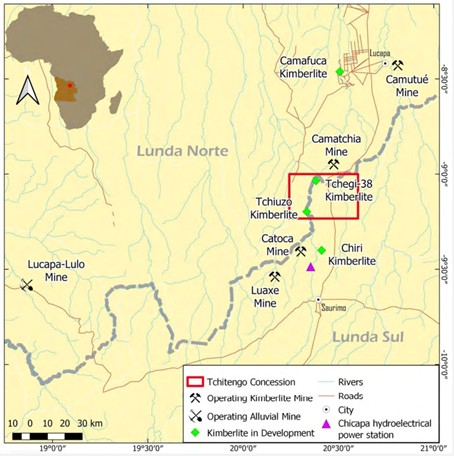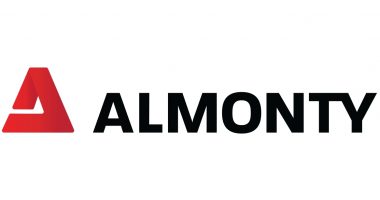Diamonds in the rough
The diamond industry is at a crossroads; Demand is projected to rise 3 per cent to 5 per cent per year, but global production is declining at a rate of 1 per cent per year. This vacuum has created prime conditions for one company with two decades worth of experience and provides a foundation for its growth strategy.
Lipari Mining Ltd. has recently started trading on the CBOE under the ticker symbol LML, marking a significant milestone for the company. With a strong foundation in diamond mining, Lipari operates a producing diamond mine in Brazil and is now focusing on developing the Tchitengo project in Angola.
This article provides an in-depth look at Lipari Mining, with a particular focus on the Tchitengo project, which is in a solid position to serve as the future of the company.
The Tchitengo Project: Near-term diamond production potential
The Tchitengo Project is a large concession in the heart of Angola’s main diamond-producing area, situated in the northeast part of the country. This region is home to the Catoca mine, which produces around 5 million carats of diamonds annually, and the newly operational Luele mine, which is expected to reach similar production levels in the coming years.
- Angola’s primary diamond district is one of the most promising regions for diamonds globally:
- 35 km north of the world-class Luele mine development, which is expected to produce 3-5 million carats annually starting in the mid-2020s.
- 19 km north of the Catoca mine, Angola’s largest diamond producer, with an annual output of 5.6 million carats.
- 19 km north of the Chiri kimberlite, currently being developed by Rio Tinto.
- The concession spans over 1,000 km² and is located 780 km from the capital city, Luanda, and 64 km north of Angola’s new “Diamond Development Hub” in the city of Saurimo.
- Travel to Saurimo from Luanda is accessible via the 945 km paved highway known as the “Catete Road” or through daily commercial flights.
- The 34 MWh Chicapa hydroelectric power station, located just 32 km south of the property, offers a potential future source of hydroelectric power for the project.
Lipari’s concession covers 30 kimberlites, with the most advanced deposit being the Tchiuzo kimberlite. Discovered by ALROSA in 2005 and brought to feasibility in 2013, the Tchiuzo kimberlite has an outlined resource containing 23 million carats of diamonds, open-pittable down to a depth of 250 metres.

A Phase II bulk sampling program will commence in Q2-2025 to recover more than 5,000 carats of diamonds to confirm the diamond grade and sales value. The Phase II bulk sampling program is projected to cost US$7.4 million and is expected to require 12 months to complete.
Tchitengo Project history
- The Tchitengo Project’s mineral concession consolidates areas previously explored by Sociedade Mineira de Catoca Lda. (SMC) and a joint venture between BHP Billiton and Banco Espirito Santo (BHP JV):
- SMC explored the southern part of the current Tchitengo Project and discovered the 9.6-hectare Tchiuzo kimberlite.
- SMC invested US$35.6 million in exploring this kimberlite, advancing the deposit to the pre-feasibility stage between 2006 and 2015.
- In July 2009, SMC reported mineral resources for the Tchiuzo kimberlite, stated to Russian standards (NAEN Code, not compliant with NI 43-101 standards), totalling more than 53.5 million tonnes of mineral resources containing more than 23.3 million carats of extractable diamonds.
- The BHP JV explored the northern part of the current Tchitengo Project from 2006 to 2011, discovering 29 kimberlite pipes:
- The BHP JV reportedly spent US$25 million on exploration and advanced the Tchegi 38 kimberlite to the bulk sampling stage.
- The Angolan Mineral Resources National Agency (ANRM) awarded SOPEMI, Lipari’s Angolan subsidiary, the rights to explore and develop both alluvial and kimberlite deposits on the Tchitengo Property.
Lipari has recently completed a 3,723-metre drill program to confirm this resource and plans to announce the results shortly. The new resource will be compliant with NI 43-101 standards, paving the way for the bulk sample program and trial mining.
Braúna Mine and other projects
In addition to the Tchitengo project, Lipari operates the Braúna mine in Brazil, which has transitioned from an open-pit operation to an underground mine. Its 100-per-cent owned Braúna mine is expected to produce around 140,000 carats of diamonds this year, generating gross revenue of approximately US$25 million. This transition has extended the mine’s production life by another four years.
Lipari also has early-stage projects in Canada (Ogoki) and Brazil (Jaibaras). The Ogoki project involves drilling magnetic anomalies that could be kimberlite targets, while the Jaibaras project has four large diamond-bearing kimberlites discovered by De Beers in the late 1980s.

Foreign investments and economic impact
The Tchitengo project has attracted significant foreign investment, which is crucial for both Lipari and Angola. The project’s capital cost is estimated to be between US$160 million and US$200 million, which is reasonable given the size of the deposit. The infrastructure in the region is well-developed, with hydroelectric power and paved roads nearby, facilitating the project’s development. The project is expected to create numerous jobs, boosting the local economy.
President Lourenço’s administration, in place since September 2017, has introduced key economic reforms that have boosted foreign investment and participation in Angola’s oil, gas, and mining industries. The government has enacted stringent anti-corruption laws. Significant amendments to mining legislation have led to a revival of foreign investment in the sector, particularly in diamonds and copper.
In April 2022, De Beers announced their return to Angola after a two-decade hiatus to actively explore for diamonds. In February 2024, they signed a memorandum of understanding to advance Angola’s diamond sector, with a particular focus on increasing diamond production. In May 2024 De Beers announced that they are suspending exploration expenditures in Canada and are devoting 100 per cent of the exploration budget on Angola.
Different stages of development, different parts of the world
Lipari’s strategy of focusing on countries they are familiar with, such as Brazil and Angola, provides a significant advantage. Both countries share a common language and legal system, reducing the learning curve for Lipari’s team. This familiarity extends to environmental permitting processes, making it easier for the company to navigate regulatory requirements.
Industry trends and market position
The diamond mining industry is facing a decline in production as several mines reach economic depletion. For instance, the Victor Mine in Ontario closed in 2019 and the Diavik and Ekati mines in Canada are nearing the end of their operational lives, with the Diavik mine operated by Rio Tinto scheduled to close in 2026.

Roughly four years ago, Rio Tinto’s world-class Argyle mine in Australia closed – at one point the mine accounted for upwards of 40 per cent of global diamond supply.
This decline in production, coupled with increasing demand, creates a vacuum, a favourable market environment for Lipari. The company is well-positioned to fill the supply gap with its advanced projects like Tchitengo.
Responsibly sourced diamonds
Lipari is committed to producing responsibly sourced diamonds. The company adheres to the Kimberley Process Certification System, working to ensure that all diamonds are conflict-free. This commitment to ethical practices enhances Lipari’s reputation and appeal to socially conscious investors.
Leadership team
Lipari’s leadership team is led by president and CEO Ken Johnson, a diamond geologist with over 40 years of experience.
Other key members include:
Co-chair and director Luiz Bizzi holds a PhD in kimberlite geology from the University of Cape Town, South Africa and was the South American technical director for De Beers for 15 years.
Co-chair and director Maurice Aftergut is the managing director of Lipari Holdings BV and has been active in the diamond industry for more than 45 years.
President of Angolan subsidiary and director, Augusto Paulino Neto is the chair of the Standard and Chartered Bank in Angola and is the managing director of SOPEMI, the Angola-registered operating company for the Tchitengo project.
Vice president, operations Christian Schobbenhaus graduated with a degree in Geology from the University of Brasília, Brazil. He started work in diamond exploration as a student in the 1990s with De Beers working in the Chapada Diamantina area of Bahia state. He has 20 years of mining industry experience, most of which has been focused on diamond exploration in Brazil.
Finance director Geovani Mariz has 15 years of industry experience in all phases of a diamond project including exploration, development, operation, and commercial production. Geovani holds an MBA degree in Finance and undergraduate degrees in Economics and Accounting.
This experienced team brings a wealth of knowledge and expertise to the company, driving its success in the diamond mining industry.
Future outlook
The demand for natural diamonds is expected to remain strong, driven by increasing global wealth and disposable income.
Demand growth is anticipated to be driven by an expanding consumer base in major markets such as the U.S., China, and India. In 2024, global diamond jewelry demand hit a high of nearly US$90 billion. Currently, China and India together account for a quarter of global demand and could surpass the U.S., which presently represents half of global demand, by the end of the decade.
Lipari’s focus on advancing its Tchitengo project and maintaining production at the Braúna mine positions the company for significant growth. Over the next 12 months, Lipari will focus on announcing the new NI 43-101 compliant resource for Tchitengo, advancing the bulk sample program, and maintaining production targets in Brazil.
Investor corner
Lipari Mining Ltd. (Cboe CA:LML) presents a compelling investment opportunity with its advanced Tchitengo project, experienced leadership team, and commitment to responsible diamond sourcing. Investors should consider deepening their due diligence into Lipari Mining as the company is well-positioned to capitalize on favorable market conditions and drive future growth.
To keep up with the latest developments from one of the newest stocks on the CBOE marketplace, visit Lipari Mining’s website.
This is sponsored content issued on behalf Lipari Mining Ltd., please see full disclaimer here.
(Top image via Lipari Mining Ltd.)






